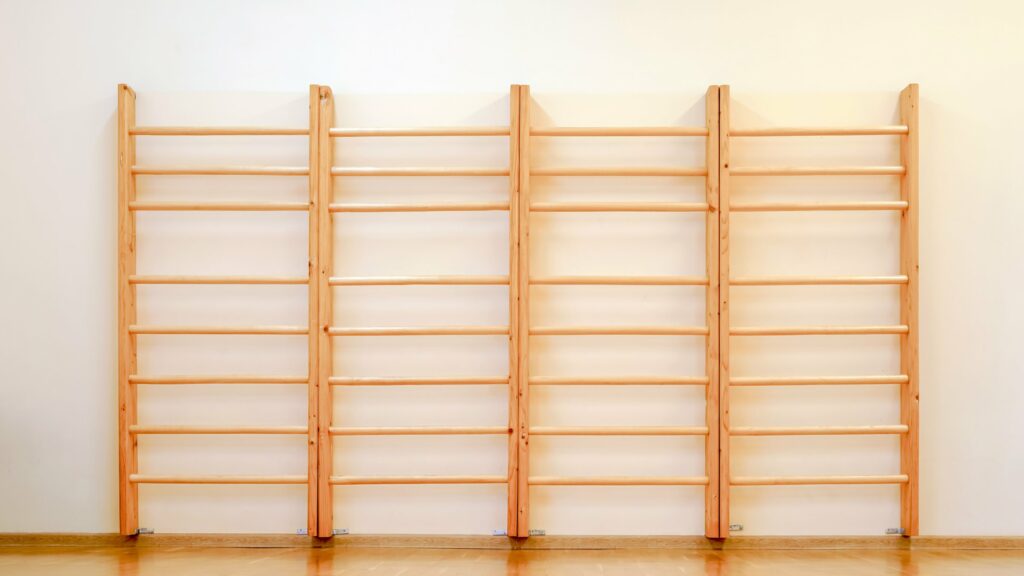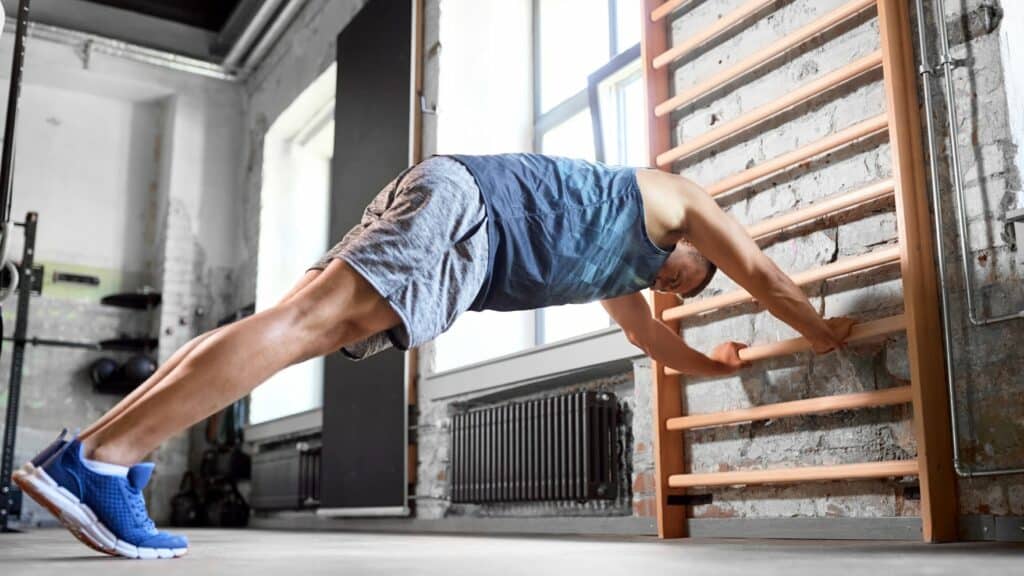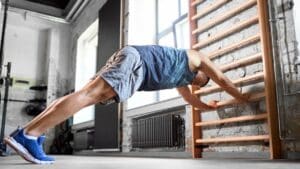
In a world of high-tech gym equipment and gadgetry, the Swedish ladder—also known as a gymnastic ladder, wall bars, or stall bars—often goes unnoticed, yet it remains one of the most versatile pieces of equipment in any gym. Invented at the beginning of the 19th century, this minimalist yet powerful tool has served various users across generations, including gymnasts, fitness buffs, and those in recovery. Today, the Swedish ladder is experiencing a renaissance in home gyms, not just for its compact footprint but for its many uses, from bodyweight, calisthenics and TRX exercises to yoga and Pilates.
Each rung of the ladder presents an opportunity to explore, adapt, and transform your routine in ways you might not have envisioned. So, as you dive into this list of Swedish ladder exercises, keep an open mind and envision the potential. Safety is paramount, of course, but with the Swedish ladder, you’re not just working out; you’re elevating your fitness experience in the comfort of your home, all within the span of a few square feet. Let’s get ready to unlock the full spectrum of what your workouts can be.
Upper Body Workouts on the Swedish Ladder

Beginner Exercises ———————————————
Hanging Shoulder Shrugs
Hang from the highest rung with both hands, fully extend your arms, and relax your shoulders. Lift your shoulders towards your ears in a shrugging motion, then lower them back down. Aim for 3 sets of 8-10 repetitions.
Targets: Traps (trapezius muscles), deltoids, and grip strength.
Assisted Pull-ups
Stand beneath the ladder and place your feet on a lower rung for support. Grasp a higher rung with both hands and perform a pull-up, using your legs to assist as needed.
Targets: Latissimus dorsi, biceps, and upper back.
Tricep Extensions
Stand facing toward the ladder, place your hands on a comfortable rung, and lean towards the ladder by bending and straightening your arms with tricep extensions. Keeping your body straight, lower your body by bending the elbows until your head is just below the rung, then extend your arms to raise back up.
Targets: Triceps, shoulders, and core stability.
Swedish Ladder Dips
Sit face away from the ladder, reach back, place your hands on a comfortable rung, and perform dips.
Targets: Triceps, shoulders, and chest. Strive for 3 sets of 6-10 dips.
Intermediate Exercises ———————————————
Decline Push-ups
Position your feet on a lower rung and perform push-ups, engaging the core. Aim for 3 sets of 10-15 repetitions.
Targets: Chest, shoulders, core, and triceps.
Dips on the Dip Bar:
If your Swedish ladder setup includes a dip bar, position yourself above the bars with your arms straight and legs bent to avoid touching the ground. Lower your body by bending the elbows until they are at a 90-degree angle, then push back up.
Targets: Chest, triceps, and anterior deltoids.
Assisted Pull-ups
Stand beneath the ladder and place your feet on a lower rung for support. Grasp a higher rung with both hands and perform a pull-up, using your legs to assist as needed.
Targets: Latissimus dorsi, biceps, and upper back.
Front Support for Straight Arm Strength
Facing the ladder, place your hands on two rungs at waist height, and lean forward to create a straight line with your body. Hold this position, keeping your body straight and arms fully extended. To get started, use a lower bar to assist.
Targets: Shoulders, chest, core, and arm stabilizers.
Advanced Exercises ———————————————
Archer Pull-ups
Archer pull-ups focus on isolating each side of your upper body more intensely than regular pull-ups. Grip the ladder with one hand in the normal pull-up position and the other hand extended outwards, gripping a further rung. Pull yourself up towards the hand that is closer to the center, keeping the other arm straight, mimicking an archer’s pose. Alternate sides to ensure balanced strength development.
Targets: Lats, biceps, and shoulders, with an emphasis on unilateral strength and stability.
Typewriter Pull-ups
Perform a pull-up and, at the top of the movement, shift your weight from one side to the other, moving horizontally as if you’re a typewriter carriage. Return to the center and then lower yourself down. This exercise increases time under tension for the muscles, enhancing growth and endurance.
Targets: Upper back, shoulders, core, and arms, with a focus on enhancing muscular endurance and control.
Swedish Ladder Handstand Push-ups
Start by getting into a handstand position against the ladder, using the rungs to stabilize your feet. Carefully lower yourself by bending your elbows until your head nearly touches the floor, then push back up to the starting position. This can be performed facing towards or away from the ladder, depending on which feels more stable.
Targets: Shoulders, triceps, and core, with significant emphasis on balance and body control.
Leg and Lower Body Workouts on the Swedish Ladder
Beginner Exercises ———————————————
Step-ups
Stand facing the ladder and step onto a lower rung with one foot, pushing through your heel to bring your other foot up to meet it. Step back down and repeat, alternating legs. This exercise can be performed at a slow pace to focus on stability and muscle engagement.
Targets: Quads, hamstrings, and glutes, with an emphasis on balance and coordination.
Squats with Ladder Support
Face the ladder, holding onto two rungs at shoulder height. Perform a squat while using the ladder for balance, ensuring your knees don’t extend past your toes. Push back up through your heels to return to the starting position.
Targets: Glutes, quads, and hamstrings, focusing on form and depth of the squat.
Glute Bridges
Lie on your back with your feet placed on a low rung, knees bent. Lift your hips towards the ceiling, squeezing your glutes at the top, then lower back down. This exercise can be modified by raising one leg for a single-leg glute bridge.
Targets: Glutes, hamstrings, and core, emphasizing glute activation and hip stability.
Calf Raises with Ladder Support
Face the ladder and hold onto a rung at chest height for balance. Raise your heels as high as possible, coming onto your toes, then lower them back down. This can be done with both feet together or one foot at a time for added difficulty.
Targets: Calves, focusing on strengthening and toning the lower leg muscles.
Intermediate Exercises ———————————————
Bulgarian Split Squats
Stand facing away from the ladder and place one foot on a rung behind you at knee height. Squat down by bending your front knee and keeping your torso upright. Push through your front foot to return to the starting position.
Targets: Quads, hamstrings, and glutes, with a focus on unilateral strength and stability.
Lateral Squats
Stand side-on to the ladder with one hand for support. Perform a squat by stepping out to the side with one leg, keeping the other leg straight. Return to the starting position and repeat on the other side.
Targets: Quads, glutes, and adductors, focusing on lateral movement and stability.
Single Leg Deadlifts
Stand on one leg facing the ladder, holding onto a rung for balance. Hinge at the hips to lower your torso and reach towards the ground, keeping the other leg extended behind you. Return to the starting position.
Targets: Hamstrings, glutes, and lower back, focusing on balance, stability, and unilateral strength.
Advanced Exercises ———————————————
Pistol Squats to a Rung
Stand on one leg facing away from the ladder, extend the other leg in front of you. Squat down on the standing leg to reach a rung behind you with your butt, then push back up to the starting position. This requires significant strength and balance.
Targets: Quads, hamstrings, glutes, and core, with a high demand on balance and coordination.
Jump Squats
Face the ladder and perform a standard squat. As you rise, explode up into a jump, using the ladder for slight support if needed. Land softly and descend back into a squat.
Targets: Quads, hamstrings, glutes, and calves, focusing on explosive power and plyometric strength.
Nordic Hamstring Curls
Kneel and secure your ankles under a rung. Lower your body forward with a straight waist, using your hamstrings to control the descent. Use your hands to catch yourself as you reach the ground, then push back up to the starting position.
Targets: Hamstrings primarily, with involvement of glutes and core, emphasizing eccentric hamstring strength.
Abdominal and Core Workouts on the Swedish Ladder
Beginner Exercises ———————————————
Hanging Knee Raises
Hang from a comfortable rung with your arms fully extended. Bend your knees and lift them towards your chest, focusing on engaging your core. Slowly lower your knees back to the starting position.
Targets: Lower abdominals and hip flexors, emphasizing core engagement and stability.
Plank and Walk
Start in a plank position facing the ladder with your hands on the ground. “Walk” your hands up and down the rungs while maintaining the plank position, challenging your core stability and arm strength throughout the movement.
Targets: Core, including abdominals and obliques, shoulders, and arms, focusing on dynamic stability and strength.
Side Plank with Lateral Hip Raise
Lie on your side, supporting your body on your elbow and forearm, with legs straight and feet resting on the second rung from the bottom of the ladder. Lift your hips up so your torso aligns with your legs, engaging your core and glutes. Hold the position, then repeat several times before switching sides.
Targets: Core, especially obliques and glutes, emphasizing lateral stability and strength.
Intermediate Exercises ———————————————
Swedish Ladder Windshield Wipers
Hang from a high rung with your legs lifted parallel to the ground. Rotate your legs from side to side in a windshield wiper motion, engaging your obliques and keeping your core tight.
Targets: Obliques and entire abdominal region, focusing on rotational strength and flexibility.
Sideways Knee Raises
Start in the hanging knee raise position. Instead of lifting your knees directly up, raise them sideways to the left and right into a side crunch motion, engaging the obliques and side muscles of your core more intensively.
Targets: Obliques and core for a focused side crunch effect, enhancing the engagement of lateral abdominal muscles.
Side Plank with Leg Raise
Perform a side plank with your feet stacked on a rung of the ladder. Lift your top leg as high as comfortably possible, then lower it back down, keeping your hips lifted and core engaged.
Targets: Obliques, gluteus medius, and hip abductors, focusing on lateral core strength and stability.
Advanced Exercises ———————————————
Hanging Leg Raises
Hang from a high rung with your arms fully extended and legs straight. Lift your legs as high as comfortably possible without bending the knees, using your core strength. Slowly lower them back down to the starting position.
Targets: Lower abdominals, hip flexors, enhancing core stability and strength.
L-Sit Holds on the Ladder
Sit facing the ladder with your hands on two rungs at your sides. Lift your body and extend your legs straight out in front of you, holding an “L” shape. Maintain this position as long as possible.
Targets: Core, hip flexors, and quads, emphasizing isometric strength and balance.
Dragon Flags
Begin lying on your back underneath the ladder, grabbing a rung above your head for support. Lift your entire body off the ground, keeping it straight, then lower back down in a controlled manner without letting your body touch the floor.
Targets: Entire core, emphasizing the abdominals and lower back, focusing on core strength and control.
Final Thoughts
In wrapping up our little list of Swedish ladder exercises, I hope you get a sense of what this seemingly simple piece of gym equipment has to offer. From foundational bodyweight routines to advanced calisthenics—each designed to target different muscle groups—the wall bars caters to a broad spectrum of fitness needs, embodying the essence of creativity in workout design.
As you incorporate the Swedish ladder into your workout regimen, remember, the limitation is not in the equipment but in our imagination; it’s about rethinking what this minimalist gym equipment can do for you. An opportunity to innovate, to challenge traditional exercise norms, and to craft a fitness routine that is not only effective but also enjoyable.



